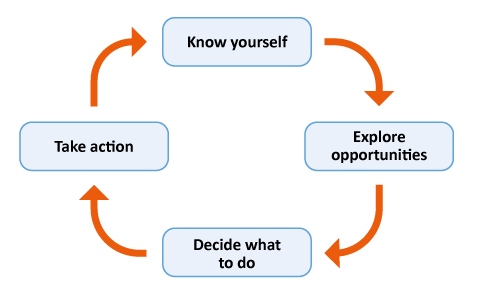1 The career planning process – where am I now?
Here’s a quick reminder of where you are in the careers planning process. You’ve already completed step one, ‘know yourself’, and are moving on to ‘explore opportunities’ now. You’re already a quarter of the way through the process – well done for sticking with it.
Now you need to match what you know about yourself to the opportunities available.
You’ll learn about the importance of this next step in the first activity of the week.
Activity 1 Why explore opportunities?
Watch this short video in which a careers adviser explains the importance of this step in the career planning process.

Transcript
Although the adviser talks specifically about paid work, the point she is making holds true for unpaid work. It is becoming rare that you can find unpaid work without the same kind of search for opportunities that you do for paid work. You may agree with some of the points made in the video, especially if they reflect your own experiences. You might disagree with some too, for the same reason. Take a few minutes to note down in your notebook your reactions to the following questions.
- How far do you agree with what the careers adviser says – do you have any personal experiences that suggest she has a good point?
- How do you feel about taking a structured approach to pursuing your aspirations?
- What challenges might adopting this approach present for you? Who might support or help you in meeting such a challenge?
Comment
As with most of the activities in this course, what you will have written down will reflect your own personal experiences. Try not to think of any challenges as obstacles, but rather as problems to be solved. In that way you can start to take control of them.
A structured approach can really help, whether you are absolutely certain of what work you want to do, or uncertain. You are fortunate if you have a very clear idea, as most people won’t be in this position. Identifying where your ideas fall in this range of possibilities is a good place to start when exploring opportunities and you’ll consider this in the next section.

